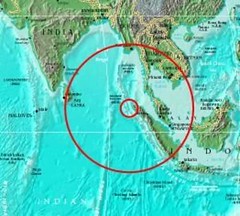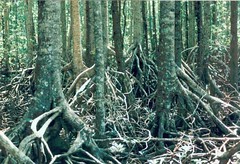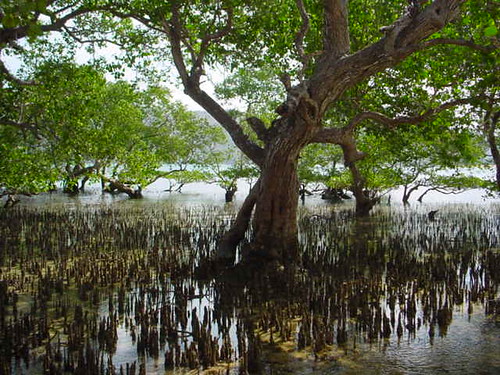tags: Environment, tsunami, earthquake, Indonesia, Mangrove, Shrimp Farming
Note: Originally published on 2 January 2005. Nominated for the 2005 Koufax Award for "Best Individual Post".
All the survivors agreed that 26 December 2004 was an idyllic morning, indeed, it was a perfect morning, in spite of the earthquake. This earthquake was triggered within an interval of a few seconds when the Indian tectonic plate suddenly plunged 20 meters (60 feet) under the Burmese tectonic plate along the Sunda Trench. This submarine jolt caused the Burmese plate and the lands perched upon it to move southwest by many meters and to simultaneously rise up by an as-yet undetermined height.
 Even though its focal point was located 160 kilometers (100 miles) west of the island of Sumatra (map pictured; located at center of small red circle), this earthquake involved an unusually large geographic area; approximately 1200 kilometers (750 miles) of the India-Burma fault line moved. This rare megathrust earthquake, measured at 9.0 on the Richter scale by the US Geological Survey (making it the fourth strongest since 1900), was felt by millions of people around the Indian Ocean as it caused our little blue planet to shudder momentarily in its graceful orbit.
Even though its focal point was located 160 kilometers (100 miles) west of the island of Sumatra (map pictured; located at center of small red circle), this earthquake involved an unusually large geographic area; approximately 1200 kilometers (750 miles) of the India-Burma fault line moved. This rare megathrust earthquake, measured at 9.0 on the Richter scale by the US Geological Survey (making it the fourth strongest since 1900), was felt by millions of people around the Indian Ocean as it caused our little blue planet to shudder momentarily in its graceful orbit.
Unknown to everyone except a handful of geophysicists -- whose forewarnings went almost completely unpublicized -- the sudden vertical thrust of the Burma tectonic plate deformed the sea floor and thereby displaced billions of gallons of seawater that had to go somewhere. This displacement created a succession of shock waves that spread outward, traveling through the Indian Ocean like a series of ripples caused by dropping a stone into a pond. These invisible shock waves raced undetected through deeper waters as fast as a passenger airplane in flight (800 kilometers/hour or 500 miles/hour).
Meanwhile, people ate breakfast, went scuba diving or dug their toes into warm sand.
But when these shock waves reach shallower coastal waters, friction with the continental shelf floor slows the first of these shock waves, allowing the trailing shock waves to pile up into those in front of them. Except for small losses of energy due to friction, the energy of these shock waves remains nearly unchanged when they reach shallow water, so they mound up into one or several giant sea waves, or tsunamis, that can reach 30 meters (100 feet) in height. The combined energy of these towering waves carries them many miles inland, crushing everything in their path. Including people.
It is estimated that more than 150,000 people died on that idyllic morning.
The aftermath of this catastrophe is beyond comprehension, causing us to ask, 'What could have been done to reduce this terrible loss of life?' Since tsunamis are rare in the Indian Ocean (the last significant one was in 1883) and because of the relative poverty of most nations in this region, it is understandable that a tsunami warning system does not exist for the Indian Ocean. Yet even in the absence of a tsunami warning system, the resulting deaths and damages could have been mitigated if one simple precaution had been observed; stop destroying mangrove forests.
 Mangrove forests (pictured, top and right) are tropical and sub-tropical wetland ecosystems located along marine coastlines, on tide flats and at the confluence of rivers emptying into the sea. Mangrove forests are a rich environment comprised of 60 or so species of trees, shrubs and other plants that thrive in extreme conditions; intense winds, turbulent tides, high salinity, and muddy anaerobic soils that are typical to warm water swamps. Mangrove trees have unique aerial roots that trap sediments before they are washed out to sea, thus preventing nearby coral reefs from choking to death, while their taproots filter salt from brackish water, thereby regulating soil salinity. Mangroves are home to a wide assortment of creatures; their root systems provide key habitat for juvenile fish and crustaceans, and for the wildlife that feed on them, including endangered animals such as Olive Ridley Turtles, White-Breasted Sea Eagles, Tree-Climbing Fish, Proboscis Monkeys, Dugongs and Bengal Tigers, while also supplying food, medicine, wood and even clothing for people.
Mangrove forests (pictured, top and right) are tropical and sub-tropical wetland ecosystems located along marine coastlines, on tide flats and at the confluence of rivers emptying into the sea. Mangrove forests are a rich environment comprised of 60 or so species of trees, shrubs and other plants that thrive in extreme conditions; intense winds, turbulent tides, high salinity, and muddy anaerobic soils that are typical to warm water swamps. Mangrove trees have unique aerial roots that trap sediments before they are washed out to sea, thus preventing nearby coral reefs from choking to death, while their taproots filter salt from brackish water, thereby regulating soil salinity. Mangroves are home to a wide assortment of creatures; their root systems provide key habitat for juvenile fish and crustaceans, and for the wildlife that feed on them, including endangered animals such as Olive Ridley Turtles, White-Breasted Sea Eagles, Tree-Climbing Fish, Proboscis Monkeys, Dugongs and Bengal Tigers, while also supplying food, medicine, wood and even clothing for people.
Mangrove forests, in combination with coral reefs, sand bars and sand dunes, buffer inland areas against the ravages of storms, typhoons and tsunamis, thereby protecting fragile shorelines from erosion as well as saving countless human lives. After last week's tsunami, these characteristics were incontrovertible in India's southern state of Tamil Nadu. It was reported that those areas of Pichavaram and Muthupet that are covered with dense mangroves suffered fewer human casualties and less damage to property compared to nearby areas without mangroves. The protective qualities of mangroves were also observed in 1999 when a cyclone in the Bay of Bengal claimed more than 10,000 lives and washed away several coastal villages in the state of Orissa on India's eastern coast. This was one of the worst cyclones in history with winds of 160 miles per hour. However, amidst all the damages, it was noted that villages in and around neighboring Bhitarkanika were spared much of the cyclone's fury: Bhitarkanika is the second largest mangrove forest in India.
But because of their desirable location, mangroves are under attack by land developers and politicians who are richly rewarded by the western world's fondness for dining on giant shrimps (also known as prawns) and for vacationing on exotic sandy beaches. As a result, more than half of the world's mangrove forests were destroyed in the previous 50 years and the remaining mangroves are being destroyed at an accelerating rate to make way for yet more beachfront hotels and large-scale shrimp farms.
But shrimp farming has been especially damaging; it is estimated that roughly one-third of all mangrove forests were replaced with commercial shrimp farms between 1986 and 1996 in southeast Asian and Indonesia, where 80 per cent of the world's shrimp farms are located. Among some of the tsunami-affected countries, for example, Indonesia lost 269,000 hectares of mangroves to shrimp ponds while Thailand lost 185,000 hectares between 1960 and 1991. Additionally, as cited in a 2002 paper by V. P. Upadhyay and colleagues in the journal Current Science, the Indonesian island of Java lost 70 per cent of its mangroves, Sulawesi 49 per cent, Sumatra 36 per cent. Globally, the rate of decline in mangrove forest cover is 2-8 per cent every year, according to another paper cited by Upadhyay's group.
 Even though fish and shrimp farming were widely practiced for centuries throughout Indonesia, the problems started when existing practices were replaced with intensive farming methods designed solely to maximize profits. Intensive farming specializes in raising a "monoculture" consisting of only one crop (or species) in densely packed groups. Most farmed shrimps are the popular "jumbo" prawns, the Penaidae. Of the Penaids, the Black Tiger Prawn, Penaeus monodon, also known as the Giant Prawn (pictured, left), is the most popular; having captured 56 per cent of the current market because it is the largest of all shrimp species. It also has an attractive color and a mild flavor that pleases finicky western palates.
Even though fish and shrimp farming were widely practiced for centuries throughout Indonesia, the problems started when existing practices were replaced with intensive farming methods designed solely to maximize profits. Intensive farming specializes in raising a "monoculture" consisting of only one crop (or species) in densely packed groups. Most farmed shrimps are the popular "jumbo" prawns, the Penaidae. Of the Penaids, the Black Tiger Prawn, Penaeus monodon, also known as the Giant Prawn (pictured, left), is the most popular; having captured 56 per cent of the current market because it is the largest of all shrimp species. It also has an attractive color and a mild flavor that pleases finicky western palates.
However, raising these monocultures provides an ideal situation for rapid disease transmission so farmers feed the shrimps large quantities of antibiotics and treat the water with pesticides to reduce unprofitable competitors. Unfortunately, although the maximum life span of a modern commercial shrimp farm is less than ten years, the resulting environmental damage outlasts it. After the farm has been abandoned, the land is barren and unusable for many decades due to contamination with antibiotics, pesticides and other chemicals, and with salt. Attempts to reclaim the land for rice farming fail. Even mangroves do not re-grow.
This environmental damage, which directly contributed to the tragic loss of life last week, is driven by western appetites: Depending upon the source country, 80-95 per cent of all farmed shrimps are exported to America (the biggest global market for shrimp), to Japan (the biggest per capita consumer of shrimp) and to the European Union. Even though we cannot stop tsunamis from occurring, each one of us can ameliorate future tsunami damage by protecting mangroves. We can become members of organizations such as the Mangrove Action Project that work to protect mangrove forests. Those of us who are lucky enough to take a holiday in the tropics should avoid staying at beachfront hotels. But most important, we all can and should avoid eating shrimp and prawns, particularly giant or black tiger prawns, in restaurants, and we should request local stores to refrain from stocking shrimp unless it can be shown that they were produced using environmentally sustainable practices.
===========
Some source materials:
Human-mangrove conflicts: The way out. [PDF] By V. P. Upadhyay, Rajiv Ranjan, and J. S. Singh. Current Science 83(11):1328-1336 (10 December 2002).
Shrimp Farming in the Asia-Pacific: Environmental and Trade Issues and Regional Cooperation.
Mangroves vital for mitigating impact of disasters.
UNESCAP Executive Summary (of mangrove ecosystems).
Chemical crustaceans: pesticides and prawn farming.
My Brain.
============
Nominated for 2005 Koufax Award, "Best Individual Post".
Included with the Best of Me Symphony
Issue 96.
Included with "The Best of Science, Nature and Medical Blog Writing"
Issue 19.



I was so happy when you sent this to Tangled Bank - that was the first carnival I ever hosted and I was nervous.
Great article! I used to read your old blog but missed this post. I'm glad you reposted it at the new site.